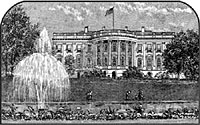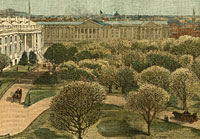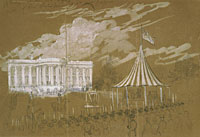South of the White House towards the Potomac River and malodorous B Street Canal lay a series of outbuildings and stables. There were also shanty settlements. The canal had been originally designed for the delivery of fruits and vegetables from the countryside to the capital. It had instead turned into the city’s largest sewage line.
Closer to the White House — and more pleasant — were the gardens and extensive South Lawn. “The parklike grounds were ideal for an occasional walk. Dogwood and redbud trees blossomed in the spring, and the horse chestnuts…were magnificent,” according to White House historian William Seale. “Random clumps of trees gave some visual protection to the house, but there was no careful screening of the White House or its gardens.”1 It was here where presidential protégé Elmer Ellsworth trained his Zouave regiment shortly after the outbreak of the Civil War in April 1861. It was a show for Washington and White House residents. “Every member of the family was expected to approve, applaud, and admire, and this we did,” wrote Elizabeth Todd Grimsley.2
Ellsworth was the first Union casualty of the war. Another close friend of the Lincolns, Senator Edward Baker, was killed several months later on October 21, 1861, one day after spending a pleasant afternoon with the Lincoln family. According to Baker’s biographers, Harry C. Blair and Rebecca Tarshis: “It had been a pleasant interlude for the Lincolns as well as for Baker. The President was seated on the lawn, which spread soft and green from the northeast side of the White House. He was leaning against a tree, looking at Baker stretched out on the grass, his hands clasped beneath his head. Both men, who had been such long and close friends, were talking in subdued and grave voices. Nearby, Lincoln’s small son Willie was happily playing with the brilliantly colored autumn leaves which descended in a graceful dance from the branches overhead.”
The biographers continued: “Finally Baker arose and shook hands with the President. Lifting Willie in his arms, Baker kissed the boy good-by. Mrs. Lincoln presented Baker with a bouquet of late autumn flowers as a token of her esteem. Baker accepted her fragrant gift with the quiet comment: ‘Very beautiful. These flowers and my memory will wither together.'” He got on his horse and rode off to his death in the Battle of Ball’s Bluff.3
There were other shows. On April 27, 1861, John Hay recorded in his diary: “The Seventh Regiment band played gloriously on the shaven lawn at the South front of the Executive Mansion. The scene was very beautiful. Through the luxuriant grounds the gaily dressed crowd idly strolled, soldiers loafed in the promenades, the martial music filled the sweet air with vague suggestions of heroism, and Carl Schurz and the President talked war.”4
In his diary entry of June 30, 1861 Benjamin Brown French described a flag raising on the South Lawn, attended by a large crowd of citizens and military and civilian officials, including General-in-Chief Winfield Scott, Secretary of State William H. Seward, Secretary of the Treasury Salmon P. Chase and Mary Todd Lincoln: “After a band played “Hail to the Chief” prayer was read by Rev. Smith Pyne, Mr. Lincoln raised the flag with mixed success: The President then took hold of the halliards & commenced raising the flag. At the place where the cloth surrounded the pole it hung hard, but the President tugged away with a will, and up it went, but, alas, when it blew out in the breeze the two upper stripes and about three of the stars were separated by a rent, and just hung like a ribbon to the rest of the flag. Although a thousand hearty cheers went up, and the band played ‘the star spangled banner,’ and the guns of the Artillery, stationed on the Monument grounds, thundered a salute, I felt a sorrow that I cannot describe, at seeing the torn flag. It seemed to me an omen of ill luck. My only consolation was observing the determined energy with which the president pulled away at the halliards — as if he said, in his mind, ‘It has got to go up whether or no.’ And I thought, ‘Well, let what reverses may come, he will meet them with the same energy, and bring us out of war, if with a tattered flag, still it will all be there!'”5
Edward Duffield Neil, later a Lincoln aide, was present at the same event: “I went there with some other offices of the [First Minnesota Infantry Regiment]. The crowd was very great. On the balcony of the President’s house sat General Scott, in full uniform, looking as majestic as old Jupiter of the ancient sculptors, while on a temporary platform around the flag-staff stood the President, ready to pull at a given signal. Among the spectators directly before me stood [Andrew Johnson], a man plainly dressed with serious countenance, with his wife by his side,” wrote Neil, who served as a presidential aide in 1864-65. “Several years after, Mr. Johnson, referring to this occasion, said an occurrence took place which the superstitious would have considered an ill omen. He told me the President pulled the rope too long, so that the bunting of the flag split, and he could but think at the time that he might be pained by the calamity of the great republic rent in twain permanently.”6
It was here on Easter Monday in 1861 and 1862, that an egg roll was held on the South Lawn. “At the rear of the White House is a sloping lawn with soft turf. The players stand on the top of the hill and watch their eggs in a race to the bottom. The one which first arrives whole is the winner; the cracked or broken ones go to the victor, who eats them or at least is expected to,” wrote Julia Taft, whose brothers played with the Lincoln boys.7 President Lincoln’s son Tad displayed his customary concern for the needy. Historian Ruth Painter Randall recalled that a Mrs. Delano “attended an Easter egg rolling on the White House lawn. She saw Tad proudly show his father the two dozen eggs the cook had dyed for him. One dozen, he said, was for him and the other was for a little lame boy named Tommy whom he was looking after. Tommy’s father had been killed in the war and his mother worked in the Treasury, and Tad was doing everything he could to make Tommy have a good time. He had a servant carry out a chair for the lame boy from which he could lean over and roll his eggs. He led his father to his protégé so that Tommy could have the thrill of shaking the hand of the President.”8
Aide William O. Stoddard wrote in April 1862: “Next Saturday afternoon, the Washington summer season is to be fairly inaugurated by the appearance of the Marine Band at its usual post in the President’s grounds. This pleasant and genial custom is one of the most attractive of all our summer arrangements, and affords the general public a delightful promenade at least as often as once a week, or rather twice a week, as the same band performs on Wednesday evenings in the handsome grounds of the Capitol.”9 Lincoln friend G. S. Hubbard recalled attempting to see President Lincoln on afternoon without success. “About six o’clock the band from the navy yard appeared and began to play, when Mr. [Thomas L.] Forrest said: ‘This is Saturday, when Forrest said: ‘This is Saturday, when the grounds are open to the public; the President will present himself on the balcony below; let us join the crowd.’ So we adjourned and filed in with the crowd.
The President, with Adjutant-Gen. [Lorenzo] Thomas, were seated on the balcony. The crowd was great, marching compactly past the President, raising their hats in salutation. As my friend and myself passed he said to me: ‘The President seems to notice you – turn toward him.’ ‘No,’ I said,’I don’t care to be recognized.’ At that moment Mr. Lincoln started from his seat, advancing quickly to the iron railing and leaning over, becking with his long arm, called: ‘Hubbard! Hubbard! come here.’ I left the ranks and ascended the stone steps to gate of the balcony, which was locked, Gen. Thomas saying: ‘Wait a moment, I will get the key.’ ‘Never mind, General,’ said Mr. Lincoln, ‘Hubbard is used to jumping – he can scale that fence.’ I climbed over and for about an hour we conversed and watched the large crowd, the rebel flag being in sight on Arlington Heights.”10
For the first time, the grounds were not restricted to white Americans. Historians James G. Randall and Richard N. Current noted: “On the fourth of July [1854] Lincoln gave permission to the colored schools of the District of Columbia to hold a celebration on the White House grounds, and on August 6 he allowed Negroes to assemble on the grounds in day-long ceremonies observing the national day of humiliation and prayer which he had ordained. In these and other ways he set an example of tolerance for all his fellow countrymen.”11 Union officer William E. Doster wrote in his diary: “A great carnival. The colored people celebrate a picnic in the President’s grounds. A stranger would imagine himself in the palace gardens of Soulouque of Hayti. Negroes in hacks, with standards on gayly-caparisoned horses, and generally in the costume of the Southern aristocracy.”12
In June 1861, a model military balloon was moored overnight on the lawn. Shortly after its arrival in Washington in May 1861, the Seventh New York Regiment band performed here. The Marine Band held concerts here late on Wednesday and Saturday afternoons. The President liked to listen to the band but he didn’t appreciate the public’s requests for speeches: “I wish they would let me sit out there quietly and listen to the music.”13
The concerts were canceled by Mrs. Lincoln in 1862 because of her extended grief over the death of her son Willie. Washington residents were not pleased. Secretary of the Navy Gideon Welles eventually intervened in May 1862 and the concerts were resumed in Lafayette Park. Among the Marine musicians was the father of John Philip Sousa, who later conducted the band and composed some of America’s most famous marches.
John Nicolay reported in a letter to his finance Therena: “We have music here in the President’s grounds every Wednesday and Saturday evening, when the grounds are open to everybody. Yesterday at about half past five there was quite a large crowd here promenading in the grounds, when all at once a very brisk firing of musketry was heard on the other side of the river. There was almost instantaneous excitement in the crowd, and everybody rushed down to the edge of the grounds where they could see across the river. Several of us went on top of the house, and with a spy-glass could see that it was no battle, but only a detachment from one of the regiments over there, engaged in practise at loading and firing at will. They kept it up for about half an hour, and we had a chance to hear what a small battle or skirmish sounds like at a distance.”14
In April 1861, John Hay wrote in his diary: “The Seventh Regiment band played gloriously on the … lawn at the south front of the Executive mansion. The scene was very beautiful. Through the luxuriant grounds, the gayly dressed crowd idly strolled, soldiers loafed on the promenades, the martial music filled the sweet air with vague suggestion of heroism, and [diplomat Carl] Schurz and the President talked war.”15
Footnotes
- William Seale,History of the White House, p. 391.
- Seale,History of the White House, p. 371.
- Harry C. Blair and Rebecca Tarshis,Colonel Edward Baker: Lincoln’s Constant Ally, p. 157.
- Michael Burlingame and John R. Tuner Ettlinger, editors,Inside Lincoln’s White House: The Complete Civil War Diary of John Hay, p. 13.
- Donald B. Cole and John J. McDonough, editors,Witness to the Young Republic: A Yankee’s Journal, pp. 361-362.
- Rufus Rockwell Wilson,Intimate Memories of Lincoln, pp. 599-600.
- Julia Taft Bayne,Tad Lincoln’s Father, p. 78.
- Ruth Painter Randall,Lincoln’s Sons, p. 107.
- Michael Burlingame, editor,Dispatches from Lincoln’s White House: The Anonymous Civil War Journalism of Presidential Secretary William O. Stoddard, p. 77 (April 28, 1862).
- Osborn H. Oldroyd, editor,The Lincoln Memorial: Album-Immortelles, p. 307 (G. S. Hubbard).
- J. G. Randall and Richard N. Current, “Race Relations in the White House,” Don E. Fehrenbacher,The Leadership of Abraham Lincoln, p. 152.
- William E. Doster,Lincoln and Episodes of the Civil War, p. 241.
- Benjamin Thomas,Abraham Lincoln, p. 474.
- Helen Nicolay,Lincoln’s Secretary, pp. 99-100.
- William Roscoe Thayer,The Life of John Hay, pp. 103-104.
Visit
Edward Baker
Elmer Ellsworth
Benjamin French
John Hay
Thomas Lincoln
William Lincoln
John Nicolay
Edward Duffield Neil
Carl Schurz










